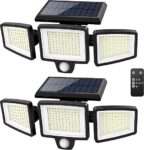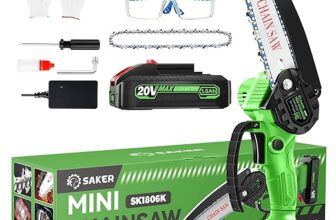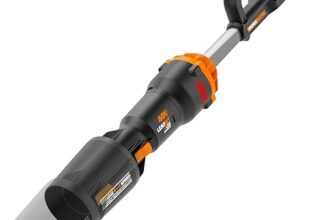
Tuffenough Solar Outdoor Lights 2500LM — Shockingly Bright for $30
Tuffenough Solar Outdoor Lights 2500LM deliver powerful, wire-free security lighting for hard-to-wire spots — mostly reliable, with a few trade-offs.
Dark entryways and gravel driveways expose a simple problem: standard solar lights are either too dim or too flimsy to be useful after sunset. Homeowners who need bright, reliable illumination without the hassle of wiring often end up choosing between weak performance and expensive installation.
The Tuffenough Solar Outdoor Lights 2500LM aim to bridge that gap. They pack up to 2,500 lumens across three adjustable heads for wide 270° coverage, include a remote and three modes, and arrive as a two-pack at a budget price — though limited remote range and occasional durability hiccups keep expectations realistic.
Tuffenough 2500LM 3-Head Solar Security Lights
They provide strong, wide-area illumination and a straightforward, wire-free setup that makes them useful for driveways, sheds, and fences. While the remote range and occasional reliability issues temper expectations, the lights are a compelling low-cost security option for hard-to-wire locations.
Ultimate Solar Light Review: Tuffenough 2500LM Outdoor Lights – Installation Guide
Overview
The Tuffenough Solar Outdoor Lights with 210 LEDs and a 2500-lumen peak output aim to replace small, wired security fixtures with an all-in-one solar floodlight. Each unit combines three adjustable lamp heads, a built-in 2000mAh rechargeable battery, a solar panel, motion sensing, and a compact remote. Sold in a 2-pack, the kit targets homeowners who need bright, easy-to-install illumination for yards, driveways, fences, and outbuildings.
Design and what’s included
The fixture is molded from ABS plastic and finished in matte black. The three heads pivot independently, enabling the user to direct light across a broad horizontal plane. A small motion sensor sits beneath the heads while the solar panel and battery are integrated into the housing.
Build quality and form factor
The lights are compact (roughly 11″ x 5.5″ x 3.5″) and relatively light, which makes them simple to mount on wood, masonry, or siding. Plastic construction keeps costs down and reduces weight, but it also means that the product relies on good design rather than heavy-duty materials for longevity. The IP65 rating signals protection against jets of water and typical outdoor exposure, though user reports suggest attention to mounting angle and seal points can influence long-term watertightness.
Performance: brightness and coverage
With 210 LEDs producing up to 2500 lumens at 6500 K, the output is unmistakably bright for a solar unit in this class. The three independently adjustable heads are the main advantage: instead of a single concentrated beam, the lights can spread across a driveway, up a fence line, or illuminate a porch and approach simultaneously. In practical use, the lights create a wide wash rather than a focused spotlight — ideal for visibility and deterrence but less suited to task lighting where a narrow, long-throw beam is needed.
Motion sensing, modes, and the remote
The fixtures use a PIR motion detector with a sensing distance typically around 26 feet. They offer three primary modes selected either at the unit or with the remote: a strong sensor mode (bright on motion), a dim sensor mode (low ambient glow with bright motion), and a strong continuous mode (sustained bright output). The remote simplifies switching between these modes and turning the unit off or on without climbing a ladder.
Remote operation is convenient, but the range is modest. Users should plan to be within a few feet of the fixture or approach the wall to make adjustments. There is no smartphone app or advanced scheduling beyond the built-in modes.
Installation and placement advice
Installation is straightforward: mark the mounting holes, drill, and fix with the supplied screws and anchors. Because the fixture is solar-powered, placement is the most important step for reliable performance. The panel needs direct sun for several hours a day; shading, north-facing walls, or under-eave positions that receive little light will compromise runtime.
Battery life and solar charging
The built-in 2000mAh lithium battery is sized for moderate nightly use. On a full charge in favorable sun, the unit will provide reliable sensor-triggered lighting overnight. The continuous strong mode consumes the battery faster and is best reserved for situations where constant illumination is required. On overcast days the charging rate drops; the manufacturer recommends switching units off during very poor weather to preserve battery health and then returning them to service after several sunful days.
Durability and weather resistance
IP65 protection means the fixtures will handle rain and normal outdoor conditions, but they are not submersible. Long-term durability hinges on both installation and occasional maintenance. A periodic check of seals, screws, and the solar panel surface will reduce the chance of moisture-related failure. The ABS housing resists rust and many forms of impact but will not have the same toughness as metal housings in high-impact environments.
A practical comparison table
| Characteristic | What to expect |
|---|---|
| Brightness | Very bright for a solar floodlight; broad wash lighting |
| Motion range | Typical PIR range up to ~26 ft; angle dependent |
| Runtime | Good on sensor modes; continuous mode reduces night runtime |
| Water resistance | IP65 — weatherproof for rain and snow, avoid immersion |
| Ease of install | Mounts with two screws; no wiring required |
Who should consider these lights
They are best for homeowners and renters who need bright, wire-free lighting for detached or hard-to-wire locations: sheds, fences, driveways, and remote corners of yards. They also work well for off-grid properties, cabins, and temporary security setups. Buyers who require deep customization, long remote ranges, or heavy industrial durability might look at higher-end hardwired options.
Maintenance notes and troubleshooting
Routine upkeep is minimal but important for dependable operation. The most common issues users report — reduced runtime and intermittent failures — often trace back to suboptimal solar exposure, loose mountings that admit water, or mechanical shocks. Replacements of units are sometimes required, and Tuffenough’s seller support has been reported as responsive in customer stories.
Final thoughts
The Tuffenough solar flood lights punch well above the expected brightness for a two-pack solar kit and make adding visible, motion-activated security lighting fast and inexpensive. They are not perfect — remote range is limited and some owners experience durability issues over long term — but for the price and convenience they are an effective solution for most residential outdoor lighting needs. The adjustable three-head array, multiple modes, and included remote make them flexible, and the two-pack format is useful for pairing zone coverage without buying multiple single units.

FAQ
Runtime varies by mode and sun exposure. In motion-sensor modes they can last all night with several hours of daytime charging; continuous bright mode shortens runtime considerably. Expect several nights of sensor-triggered operation under reasonable sun, but continuous mode may require daily sun for full night coverage.
No. The included remote has a limited effective range and works best within a few meters of the fixture. Plan to make mode changes from near the mounted unit or during installation rather than from across a large property.
They will still charge in cloudy conditions, but more slowly. Performance in winter depends on sun angle and daylight hours. Positioning the panel to capture the most daylight possible and switching off nonessential modes during extended cloudy periods will help preserve battery life.
The lights have an IP65 rating, which protects against rain and splashing water. They are designed for outdoor exposure in normal weather, but they should not be submerged or exposed to persistent ponding of water. Properly tightened mounting points and occasional inspections reduce the risk of water ingress.
Yes. Each of the three heads pivots independently, which allows users to direct light to cover wide areas or focus on multiple points of interest. For best results, aim one head at the approach path and use the others to fill adjacent blind spots.
First check mounting seals and the solar panel for debris. If the unit appears to have internal water entry or fails early, contact the seller or manufacturer for warranty support; many customers report responsive replacements for defective units. Keep proof of purchase and photos handy when filing a claim.
The brightness of solar lights can vary widely depending on their purpose. Small decorative or pathway lights usually produce 50–500 lumens, which is enough for gentle illumination. For patios, gardens, or general outdoor use, you’ll often find models in the 1,000–2,500 lumen range, offering a good balance between brightness and efficiency. High-performance solar security lights can reach 3,000–5,000 lumens, providing powerful illumination for larger areas. In some cases, premium or specialized models go even higher—up to 10,000 lumens or more—though these are less common and typically more expensive.
Most outdoor solar lights last about 2 to 5 years, depending on the quality of the materials, battery type, and exposure to weather. The LED bulbs themselves can shine for up to 10 years, but the rechargeable batteries usually need replacing after 1–2 years for optimal performance. Regular cleaning of the solar panel and timely battery replacement can extend the overall lifespan toward the higher end of the range.
Solar outdoor lights have a few disadvantages that are worth considering. They usually offer less brightness compared to wired fixtures and their performance can drop significantly in cloudy weather or shaded areas. During winter, shorter daylight hours often mean reduced runtime at night, and the rechargeable batteries typically need replacing every 1–2 years to maintain efficiency. In addition, high-quality models can come with a higher upfront cost, which may be a drawback for some homeowners.












Anyone tried only using one of the two lights in the pack (kept the spare for later)? Wondering if the seller ships them together or individually in case I want just one.
I used one and stored the other — works fine. Seller shipped both in the same package to me.
They come as a 2-pack listing on Amazon, so typically both are included in one box. The review was for the 2-pack configuration.
Overall, I recommend these as a budget security upgrade. Pros: bright (2500LM!), easy install, waterproof enough for normal conditions, remote and modes are useful. Cons: remote range and occasional reliability hiccups.
If you want something cheap, effective, and wire-free for sheds, fences, or driveways — these are a solid pick. I replaced expensive wired lights with these in a pinch and haven’t regretted it.
Just: make sure you get good sun exposure for the solar panel and watch for placement to minimize false triggers.
Yes, I’d buy again for non-critical spots. For main entrance or long-term heavy-duty security, I’d choose something wired and higher-end.
Good nuance — excellent for secondary locations, and helpful to highlight where wired solutions still make sense.
Would you buy again? I’m debating replacing my porch lights with these.
That’s a concise summary, Maya — mirrors our expert verdict. Thanks for sharing your hands-on experience.
Totally agree — haven’t needed to replace them and they surprised me for the price.
I love the cold white color (6500K) — it makes security cameras pick up details better and gives that crisp look to the yard.
A couple of nights I needed max brightness and they don’t disappoint.
If you prefer warmer tones for ambience, these are not it, but for clarity/security they’re top-notch at this price.
Exactly. Practical > cozy for me in that spot.
Wanted a warm light for my porch, so I passed. But for motion security lights, cold white is definitely practical.
Good point about camera compatibility — cold white can improve visibility in footage. We mentioned the 6500K color temperature in the specs.
Wow — I bought these last month and they really are shockingly bright for the price. Installed them above the garage and the driveway is lit up like a runway. Remote is handy for changing modes.
Minor gripe: the remote doesn’t always work through the garage door (maybe line-of-sight?), but for $30 I can’t complain.
Thanks for the feedback, Emily. The expert notes did mention the remote range can be limited — positioning and angle matter. Placing the light where the solar panel gets full sun also seems to improve responsiveness.
I had the same issue — try pointing the remote directly at the light instead of the solar panel. Works better for me. Also mounting at about 7-8 feet helped.
Good tip, Tom. Emily, did you set them to motion-only or the dim+motion mode? Motion-only gave me the best battery life.
For $30 I’ve found these to be excellent value. Bright, decent sensor, and the two-pack covers my side yard.
If you’re expecting pro security floodlights with wiring and backup battery they aren’t that — but for motion-activated solar they punch above their weight.
That’s the gist of our expert verdict too — strong low-cost option for hard-to-wire spots, with caveats about remote and occasional reliability.
Agreed. You get a lot for $29.99 on Amazon. Can’t beat the price-performance for most yards.
Motion sensors: cool when they work, spooky when they don’t.
My dog triggers them every time he trots by and it lights up like a mini stadium.
Also, sometimes they detect shadows from leaves and go off randomly — kinda funny at 3am. 😂
If you want perfect accuracy for IR detection you’d pay way more, but for scaring off burglars and lighting paths they’re great.
Owen, same here — my raccoon pal is the real MVP of midnight surprise parties. 😂
Thanks Owen — that’s a common practical point. The sensor is more of a broad PIR zone detector than a precision beam. Adjusting angle and mounting height can reduce false triggers from small animals or moving foliage.
Thanks all — I’ll try angling them more. Also: the dog likes the attention, so maybe he’s the one benefitting. 😅
If you need pet-proofing, try the dim+motion mode so it only gets super bright on larger movement. Worked for me.
Mount them a bit higher and angle downwards to reduce pet triggers. That helped with my cat.
Minor annoyance: ours keeps tripping at dusk when shadows move across the driveway and then stays on for a while.
I get that it’s motion-sensing, but it seems overly sensitive when set to the highest sensitivity.
Lowering sensitivity helps but reduces the detection range a bit. Trade-offs.
Thanks for that observation. Sensitivity and mode selection are common trade-offs with PIR motion sensors — the review mentions balancing brightness vs false triggers depending on mounting and mode.
Try setting it to dim+motion rather than full brightness at dusk. That reduced false positives for me.
I want to like these but I remain cautiously skeptical.
The build feels plasticky (not unexpected at this price).
IP65 is fine, but I had one unit fail after heavy rainstorms — maybe a seal issue?
Brightness is great when it works, though.
If you need something for light-duty, they’re a steal, but don’t expect pro-grade durability.
Try resealing the screw holes with a little silicone if you suspect leaks. Cheap fix that saved one of mine.
I live on the coast and mine have held up for a year. Maybe manufacturing variance?
Appreciate the honesty, Marcus. Our expert rating noted occasional reliability issues — your experience aligns with that. If you got a defective unit, Amazon often has an easy replacement process for these sellers.
Same here — one of mine stopped holding charge after two months. Contacted seller and they replaced it quickly via Amazon. YMMV.
Installation was ridiculously easy. No wiring, screws and done in 10 minutes. Mounting bracket and hardware felt adequate.
Got two-pack and placed one by the back gate and the other near the shed — both charged up well in a few sunny days.
Glad installation went smoothly for you, Linda. Ease of setup was one of the product’s advantages we noted in the review.
Make sure you mount them where the panel gets direct sun most of the day. I initially put one in partial shade and performance was poor.
Same — I installed them under the eaves without drilling into brick. Good low-effort upgrade.
Quick question for anyone who’s owned these longer-term: how long does the battery actually last in motion mode vs always-on? I live in an area with short winters and would like them for evening security.
Good question. Battery life varies with mode and sun exposure. In motion-only mode you should get several nights of effective use on a full charge; in dim+motion it can extend the evening coverage. Our expert notes the straightforward solar setup but recommends full sun for best results.
I get about 3-4 nights with moderate motion (front yard). If it’s cloudy a week it dips noticeably. Make sure the solar panel isn’t shaded.
Heads-up: the remote range is kinda finicky. I used it from inside the house through a closed door and it barely worked.
Works perfectly outdoors with clear line-of-sight though. So don’t expect magic from 30 feet of concrete/brick between you and the light.
I taped a cheap wireless remote extender to the window sill and that helped me a bit — hacky but effective.
Or just use the manual buttons on the unit when you’re outside. Remote is a nice-to-have, not essential.
Yep, I mostly use the buttons now. Remote is for when I’m feeling lazy 😄
Good practical tip, Hannah. The review noted the remote range as a limiter; line-of-sight and obstacles will definitely affect it.